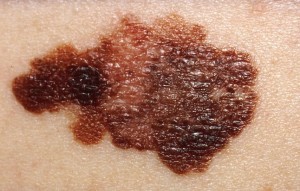By Dr. Ryan Jawitz –


People of all colors, ages, and races get skin cancer. Of all the cancers that human can get, skin cancer is the most common. In the United States, skin cancer is increasing in all races.
Q. What does skin cancer look like?
The different types of skin cancer vary in appearance.
Actinic Keratoses (AK)
Dry, scaly patches or spots considered the earliest stage in the development of skin cancer. People who get AKs usually have fair skin and see them appear after age forty since they tend to develop after years of sun exposure. However, young people who overexpose their skin to the sun or use indoor tanning can have AKs. AKs form on places that get the most exposure such as the head, neck, hands, and forearms. Proper use of sunscreen can help prevent the formation of AKs. Because they can progress to squamous cell carcinoma (SCC) AKs are typically treated.
Basal Cell Carcinoma (BCC)
As the most common form of skin cancer, BCCs frequently look like a flesh-colored, pearl-like bump and can also appear as a pinkish patch of skin. Like AKs, BCC develops on skin that gets the most exposure, but can also form on the trunk and lower limbs. Even though BCC is frequently found in fair-skinned people, it can occur in people with dark skin. Although BCC usually does not grow quickly and rarely metastasizes to other parts of the body, it should be treated promptly. This type of cancer can invade the surrounding tissue and grow into the nerves and bones, causing disfigurement.
Squamous Cell Carcinoma (SCC)
SCC is the second most common type of cancer and looks like a firm bump, scaly patch, or a sore that heals and then re-opens. It is usually reddish in color and tends to form on skin that is frequently exposed to the sun such as the rim of the ear, face, neck, arms, and trunk. Like the previously listed cancers, SCC most often occurs in fair-skinned people, but is also found in those with dark skin. Because SCC can grow deep causing disfigurement, early treatment can prevent and stop SCC from spreading to other parts of the body.
Melanoma
This deadly form of skin cancer develops in a mole or appears suddenly as a new dark spot on the skin. Every year, more than 8,500 Americans (nearly one person an hour) die from melanoma. Several risk factors significantly increase a person’s risk of developing melanoma. A change is often the first sign of melanoma. It is important to know where moles appear and what they look like. When detected early and properly treated before it spreads, melanoma has a high cure rate. The ABCDE warning signs of melanoma help people detect change.
What are the warning signs of melanoma?
- A stands for ASSYMETRY. One half unlike the other half.
- B stands for BORDER. Irregular or poorly defined border
- C stands or COLOR. Shades of tan, brown, and black and varied from one area to another. Lesions can sometimes be white, red, or blue.
- D stands for DIAMETER. Melanomas are usually greater than 6mm (the size of a pencil eraser) when diagnosed, they can be smaller.
- E stands for EVOLVING. A mole or skin lesion that looks different from the rest or is changing in size, shape, or color. Other changes that could indicate melanoma are pain, itch, or bleeding in a mole or new spot on the skin.
What are the risk factors for melanoma?
- Excessive ultraviolet (UV) light exposure: One or more severe, blistering sunburns as a child or teenager can increase your risk of melanoma as an adult. Exposure to UV radiation, which comes from the sun and from tanning beds, can increase the risk of skin cancer, including melanoma.
- Light Skin: Having less pigment (melanin) in your skin means you have less protection from damaging UV radiation. However people with skin of color do get melanoma.
- Family History: If one or more of your parents, siblings, or child has had melanoma you have a risk of developing it too.
- Number of Moles: Having many moles (50-100 or more) or several atypical moles.
- Types of Moles: An atypical mole is not cancerous, but because of its different appearance, these moles should be closely monitored for any changes.
- Medical History: Having had melanoma increases your chances of having additional melanomas.
Q. How can I protect myself from skin cancer?
Sun exposure is the most preventable risk factor for all skin cancers. You can have fun in the sun and decrease your risk for skin cancer. The American Academy of Dermatology suggests following these tips to Be Sun Smart®.
- Generously apply a broad-spectrum water-resistant sunscreen. Use a sunscreen with a Sun Protection Factor (SPF) of 30 or more to all exposed skin. Broad-spectrum provides protection from both UVA and UVB rays. Re-apply approximately every two hours, even on cloudy days, and after swimming or sweating.
- Seek shade! Remember the sun’s rays are strongest between 10 a.m. and 4 p.m. If your shadow is shorter than you are, seek shade.
- Protect children. Apply sunscreen, play in the shade, and dress children in protective clothing.
- Use extra caution near water, snow, and sand. Damaging rays of the sun are reflected which can increase your chance of sunburn.
- Avoid tanning beds. UV light from the sun and tanning beds can cause skin cancer and wrinkling. If you want to look like you’ve been in the sun consider using a sunless self-tanning product, but continue to use sunscreen with it.
- Perform periodic self-examinations. Be sure to look at your entire body every month or two. If you notice anything changing, growing, or bleeding on your skin, make an appointment to see a dermatologist.
With early detection and proper treatment, skin cancer has a high cure rate. Annual appointments to the dermatologist for skin exams help people find skin cancers early when it is most treatable. Riverchase Dermatology offers same week appointments and often serves the community with free skin cancer screenings.
Ryan Jawitz, D.O., is a dermatologist with extensive training and specializes in dermatologic surgery and Mohs Micrographic surgery as well as cosmetic rejuvenation techniques. To learn more about Dr. Jawitz visit www.RiverchaseDermatolgy.com or call 1-800-591-DERM (3376) to make an appointment in North Port.
 Southwest Florida's Health and Wellness Magazine Health and Wellness Articles
Southwest Florida's Health and Wellness Magazine Health and Wellness Articles

